How To Clean A Chainsaw Chain: Easy Care and Maintenance
- February 12, 2024
- 0 comment
Cleaning a chainsaw chain is essential for maintaining its efficiency and prolonging its life. Over time, chains can become clogged with sap, dirt, and debris, leading to decreased performance and potential damage. Today, I’m going to share a secret method that will help you clean your chainsaw chains, removing all that pitch and grime, making them look like new again. This method is surprisingly simple, yet incredibly effective. Let’s dive in!
What You’ll Need:
- A bucket large enough to submerge your chain
- Water
- Household lye (also known as sodium hydroxide or caustic soda)
- Gloves and safety glasses
- A hose or pressure washer (optional)
- Paper towels or a clean cloth
- A wire brush (optional)
Step-by-Step Guide How to Clean a Chainsaw Chain
Proper maintenance of your chainsaw chain is essential for its performance and longevity. Follow this detailed guide to clean your chainsaw chain effectively and safely.
Step 1: Prepare Your Cleaning Solution
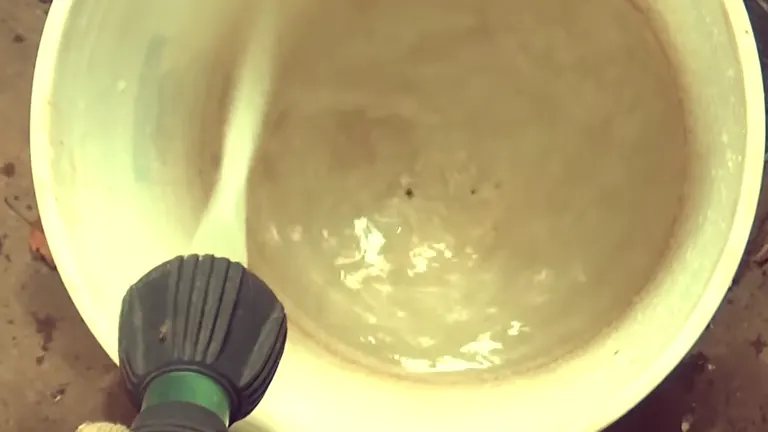
Begin by filling a bucket with water, ensuring there’s enough to completely submerge your chainsaw chain. If you’re only cleaning one chain, the water level should be a few inches above the chain to allow for full immersion. Next, carefully add household lye to the water, using a few tablespoons for a standard cleaning session. The exact amount of lye needed will depend on the volume of water in your bucket and the number of chains you’re cleaning. Lye is an effective cleaner but can be hazardous, so it’s important to avoid direct contact with your skin or eyes and to not inhale the fumes.
For this cleaning process, I used Rooto Drain Opener.
Step 2: Soak the Chain
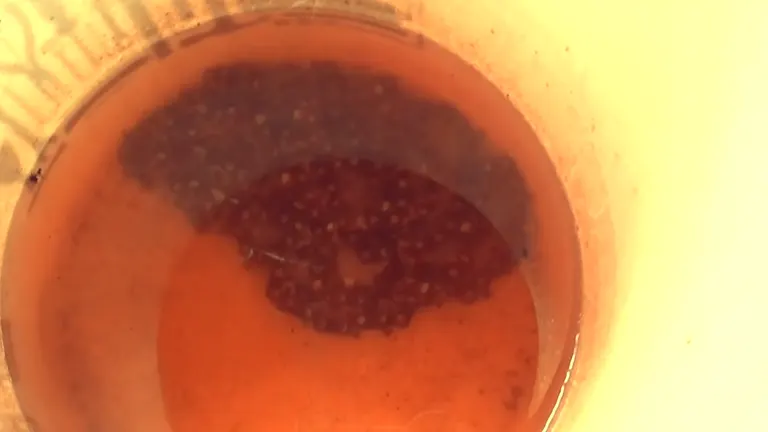
Once your cleaning solution is ready, submerge your dirty chainsaw chain in the lye solution, making sure it is fully covered by the water. Let the chain soak for about 15 to 20 minutes. If the chain is particularly dirty, you might consider letting it soak a bit longer. However, avoid leaving it in the solution for extended periods, such as hours or overnight, as prolonged exposure to water can lead to rusting.
Step 3: Remove and Rinse
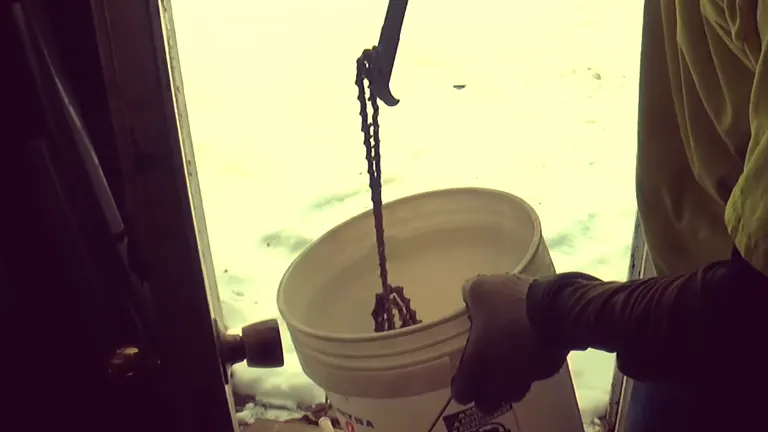
After the soaking period, carefully remove the chain from the solution, being mindful not to splash any solution on yourself. Then, rinse the chain thoroughly with a hose or pressure washer to remove all traces of the lye solution and any loosened debris. It’s crucial to ensure that no chemical residues remain on the chain to prevent potential damage.
Step 4: Dry and Clean Further
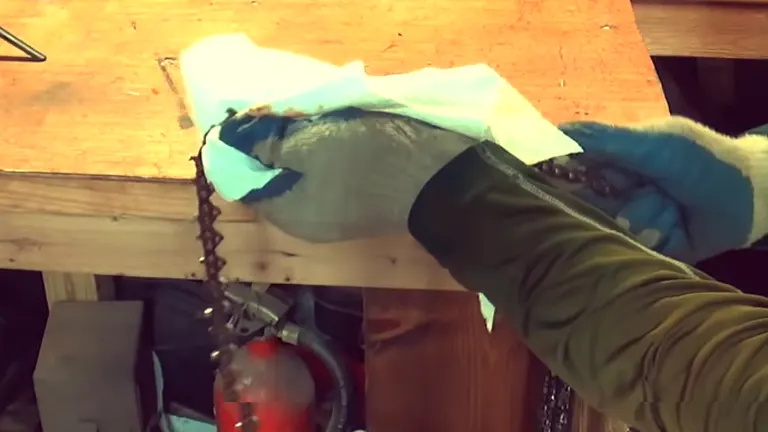
Next, use paper towels or a clean cloth to dry the chain as much as possible. To achieve a more thorough clean, you can use a wire brush to remove any remaining dirt or debris lodged between the links. Additionally, pulling a paper towel or cloth through the links can help in removing any leftover grime, ensuring that your chain is as clean as possible.
Step 5: Final Steps

After the chain is clean and completely dry, it’s important to re-lubricate it by dipping it in oil. This step is vital because the cleaning process removes all the existing oil that protects the chain from rust and corrosion. Re-lubricating the chain helps to restore its protection and ensures smooth operation during use.
Tips and Warnings for Cleaning Your Chainsaw Chain
When undertaking the task of cleaning your chainsaw chain, especially using powerful chemicals like lye, it’s important to prioritize safety and environmental responsibility. Here are some essential tips and warnings to keep in mind:
- Safety First: The use of gloves and safety glasses cannot be overstated when handling lye (sodium hydroxide). This chemical is highly caustic and can cause severe skin burns and eye damage upon contact. Protective gear will shield you from potential irritation or injury, ensuring a safer cleaning process. Consider also wearing long sleeves and pants to protect your skin further.
- Do Not Mix Chemicals: Lye should never be mixed with acidic cleaners, bleach, or any other household chemicals. Combining lye with these substances can trigger dangerous chemical reactions, leading to the release of toxic fumes that are harmful to both your health and the environment. Always use lye in a well-ventilated area and store it safely away from other chemicals.
- Disposal: After cleaning your chainsaw chain, the lye solution must be disposed of responsibly. Do not simply pour it down the drain or into the environment. Different areas have specific regulations for disposing of hazardous materials like lye. Check with your local waste management authorities for guidelines on how to dispose of the solution properly to prevent environmental damage and adhere to legal requirements.
By following these tips and heeding the warnings, you can ensure that your chainsaw chain cleaning process is not only effective but also safe for you and the environment. Regular maintenance of your chainsaw, including proper cleaning, will extend the life of your equipment and keep it running smoothly.
Troubleshooting Tips for Cleaning Your Chainsaw Chain
- If you notice rust forming on your chain after cleaning, it’s likely due to improper drying before storage or the chain being left in the cleaning solution for too long. To resolve this, soak the chain in a mixture of water and rust remover according to the product’s instructions. Afterward, thoroughly dry the chain and apply a light coat of oil to protect it from further rusting.
- If a chain has been left in the cleaning solution for an extended period and shows signs of corrosion or damage, remove it from the solution immediately. Rinse it thoroughly with clean water, dry it, and assess the extent of the damage. Light corrosion might be treatable with rust remover, but significant damage may require professional advice or replacement.
Maintenance Advice for Your Chainsaw Chain
- Regularly check your chain for signs of wear, including dull blades, damaged links, or stretched chains that don’t fit the bar properly. A worn chain can decrease your chainsaw’s efficiency and increase the risk of accidents.
- A properly tensioned chain should snugly fit on the chainsaw’s guide bar but still be able to rotate freely by hand. Overly tight chains can lead to premature wear, while too loose chains can be dangerous and may come off the bar.
- If your chain is dull and you’re not comfortable sharpening it yourself, consider seeking professional sharpening services to ensure optimal performance. Chains that are excessively worn or damaged should be replaced to maintain the safety and efficiency of your chainsaw.
Conclusion
Cleaning your chainsaw chain doesn’t have to be a daunting task. With this simple yet effective method, you can remove all the accumulated pitch and grime, restoring your chain’s performance and appearance. Remember, regular maintenance not only extends the life of your chainsaw chain but also ensures your safety while using the equipment.
Related Articles:
- How STIHL Chainsaw Protective Chaps Work
- What You Need to Know About Chainsaw Chain Brakes
- How To Fix A Chainsaw If It Won’t Oil The Bar And Chain
- What Size Chainsaw Do I Need?
- Top Reasons Chainsaw Starts, Then Stalls
- What is the Fuel Mixture for a STIHL Chainsaw?
- How To Replace Echo Chainsaw Chain: 15 Easy Steps
FAQs
- Can I reuse the lye solution for multiple chain cleanings, or should I make a new batch each time?
While you might be tempted to reuse the lye solution, it’s best to make a new batch for each cleaning session. The effectiveness of the solution diminishes as it becomes saturated with grease and debris from the chains. - Is there an eco-friendly alternative to using lye for those concerned about chemical use?
For a more environmentally friendly approach, you can use a mixture of baking soda and water or white vinegar and water. These solutions are less potent than lye but can be effective for lighter cleaning tasks. - I’ve heard that ultrasonic cleaners are also an option for cleaning chainsaw chains. How do they compare to the lye cleaning method?
Ultrasonic cleaners can be an excellent, albeit more expensive, alternative to manual cleaning methods. They use high-frequency sound waves to remove dirt and grime without the need for harsh chemicals. However, for heavy-duty cleaning, the lye method might still be more effective. - How often should I clean my chainsaw chain to keep it in optimal condition?
The frequency depends on how often and intensively you use your chainsaw. As a general rule, inspect your chain for cleanliness after every use, and aim to clean it thoroughly every few months or after about 10 hours of use. - Can the lye cleaning method be used on other parts of the chainsaw, like the bar or the engine?
It’s not recommended to use lye on other parts of the chainsaw, especially the engine. Lye is caustic and can damage metal surfaces and components. For cleaning other parts of the chainsaw, consult your user manual for recommended methods and products. - Q6: What should I do if I accidentally get the lye solution on my skin or in my eyes?
If lye comes into contact with your skin, rinse immediately with plenty of water for at least 15 minutes and seek medical advice. In case of eye contact, flush your eyes with water for at least 15 minutes and seek immediate medical attention. Always wear protective gear to minimize these risks. - Is there a significant difference in cleanliness when using a pressure washer compared to just rinsing the chain with a hose?
Yes, a pressure washer can more effectively remove residues from the chain, especially from hard-to-reach areas between the links. However, it’s important to handle the pressure washer carefully to avoid damaging the chain. - After cleaning with lye, why is it important to oil the chain immediately?
Cleaning with lye strips away all the protective oil from the chain, leaving it vulnerable to rust and corrosion. Oiling the chain immediately after cleaning helps to protect it from moisture and ensures it remains in good working condition.
We’ve reached the end of our journey on how to get your chainsaw chain sparkling clean, but the conversation doesn’t have to stop here!
Got a trick up your sleeve or a question that’s been buzzing through your mind? Don’t keep it to yourself—drop us a comment below! Your experiences and queries enrich our community, sparking more insights and ideas. And if you found this secret cleaning method as exciting as we did, share this article with your fellow chainsaw enthusiasts. Let’s keep the tips, tricks, and chains rolling!

David Murray
Forestry AuthorI'm David Murry, a forestry equipment specialist with a focus on chainsaw operation. With over 13 years of experience, I've honed my skills in operating and maintaining a wide range of machinery, from chainsaws to log splitters. My passion for the outdoors and commitment to sustainable forestry drive my work, which emphasizes safety, efficiency, and staying updated with industry advancements. Additionally, I'm dedicated to sharing my expertise and promoting environmental awareness within the forestry community.

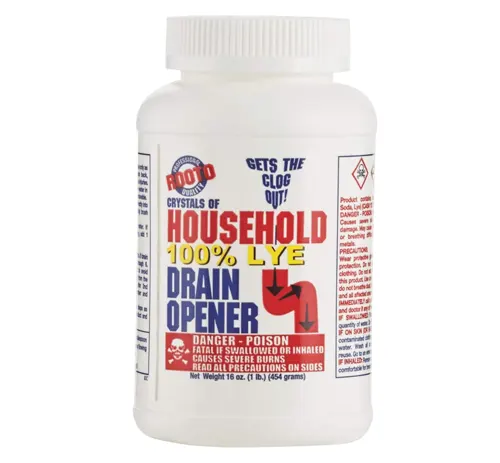












Leave your comment